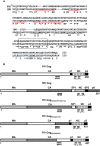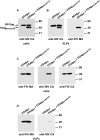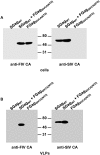Analysis of the functional compatibility of SIV capsid sequences in the context of the FIV gag precursor
- PMID: 28475623
- PMCID: PMC5419655
- DOI: 10.1371/journal.pone.0177297
Analysis of the functional compatibility of SIV capsid sequences in the context of the FIV gag precursor
Abstract
The formation of immature lentiviral particles is dependent on the multimerization of the Gag polyprotein at the plasma membrane of the infected cells. One key player in the virus assembly process is the capsid (CA) domain of Gag, which establishes the protein-protein interactions that give rise to the hexagonal lattice of Gag molecules in the immature virion. To gain a better understanding of the functional equivalence between the CA proteins of simian and feline immunodeficiency viruses (SIV and FIV, respectively), we generated a series of chimeric FIV Gag proteins in which the CA-coding region was partially or totally replaced by its SIV counterpart. All the FIV Gag chimeras were found to be assembly-defective; however, all of them are able to interact with wild-type SIV Gag and be recruited into extracellular virus-like particles, regardless of the SIV CA sequences present in the chimeric FIV Gag. The results presented here markedly contrast with our previous findings showing that chimeric SIVs carrying FIV CA-derived sequences are assembly-competent. Overall, our data support the notion that although the SIV and FIV CA proteins share 51% amino acid sequence similarity and exhibit a similar organization, i.e., an N-terminal domain joined by a flexible linker to a C-terminal domain, their functional exchange between these different lentiviruses is strictly dependent on the context of the recipient Gag precursor.
Conflict of interest statement
Figures









Similar articles
-
Properties and Functions of Feline Immunodeficiency Virus Gag Domains in Virion Assembly and Budding.Viruses. 2018 May 16;10(5):261. doi: 10.3390/v10050261. Viruses. 2018. PMID: 29772651 Free PMC article. Review.
-
Lentiviral Gag assembly analyzed through the functional characterization of chimeric simian immunodeficiency viruses expressing different domains of the feline immunodeficiency virus capsid protein.PLoS One. 2014 Dec 2;9(12):e114299. doi: 10.1371/journal.pone.0114299. eCollection 2014. PLoS One. 2014. PMID: 25462889 Free PMC article.
-
Functional relationship between the matrix proteins of feline and simian immunodeficiency viruses.Virology. 2004 Nov 10;329(1):157-67. doi: 10.1016/j.virol.2004.07.029. Virology. 2004. PMID: 15476883
-
The Conserved Tyr176/Leu177 Motif in the α-Helix 9 of the Feline Immunodeficiency Virus Capsid Protein Is Critical for Gag Particle Assembly.Viruses. 2019 Sep 4;11(9):816. doi: 10.3390/v11090816. Viruses. 2019. PMID: 31487820 Free PMC article.
-
FIV Gag: virus assembly and host-cell interactions.Vet Immunol Immunopathol. 2010 Mar 15;134(1-2):3-13. doi: 10.1016/j.vetimm.2009.10.003. Epub 2009 Oct 14. Vet Immunol Immunopathol. 2010. PMID: 19910057 Free PMC article. Review.
Cited by
-
Properties and Functions of Feline Immunodeficiency Virus Gag Domains in Virion Assembly and Budding.Viruses. 2018 May 16;10(5):261. doi: 10.3390/v10050261. Viruses. 2018. PMID: 29772651 Free PMC article. Review.
References
MeSH terms
Substances
LinkOut - more resources
Full Text Sources
Other Literature Sources

